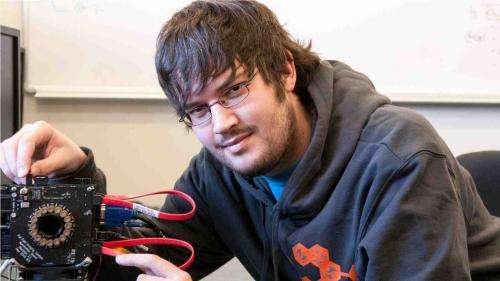Solving a moving problem

Victoria University graduand Ben Drayton has come up with a way to help solve the problem of measuring distance to a moving object.
By developing what his PhD supervisor describes as a "world-first technique", Ben's research is enabling an emerging measurement technology, called an indirect time-of-flight camera, to function more effectively.
The 24-year-old student from Wellington, who graduates with his doctorate in Electronic Engineering tomorrow, says there are many situations when distance needs to be measured, such as in forensic scene examinations of car crashes, sail profiles in America's Cup yachts, architecture, mobile robot navigation, film production, and computer gaming.
"When you are dancing around in front of the screen playing a computer game, this technology is the thing which detects your movements," he says.
The traditional way of measuring distance is to laser scan a scene, point by point, but this method takes a long time. Others have used two cameras and tried to work out the distances by comparing the two images, which is complex.
Ben's method is far simpler. "It only needs one camera lens, and all of the processing capacity can be put onto a small board so the entire unit is no larger than a standard camera."
A time-of-flight camera works out distance based on the speed of light, measuring a light signal between the camera and the subject for each point of the image. However, says Ben, errors often creep in when the target, or the camera, is moving.
By carrying out a combination of theoretical and experimental research, Ben came up with a solution to the problem—he found a different algorithm that automatically accounts for objects moving with a constant velocity.
"I did a fair number of computer simulations and theoretical derivations to show how it should work, and had a conveyor-belt that I could move objects along repeatedly so I gathered real data using that to verify it. The algorithm eliminated the error," he says.
"Ben's new algorithm for range-finding cameras will hugely increase the number of applications these cameras can be used for," says his PhD supervisor, Professor Dale Carnegie from Victoria's School of Engineering and Computer Science. "He has determined a world-first technique to overcome a number of these motion problems."
Provided by Victoria University




















